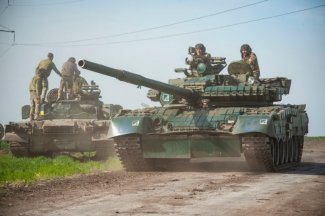Both sides shift positions on the frontline. Day 519 of the war

On 27 July, Ukrainian forces liberated Staromayorske, south of Velyka Novosilka, deepening their encroachment into the areas controlled by the Russians before the offensive began (4 June) to 8.5 km. The invaders have not yet started fighting to hold the village, but their counter-attacks so far (including an attempt to outflank the Ukrainian troops from the north with a strike on Makarivka) have failed. The seizure of Staromayorske brings the Ukrainian forces closer to the enemy’s first line of fortifications (in the area of Staromlynivka, to which they have to move a further 5 km), and makes it easier for them to strike at the neighbouring village of Urozhayne. However, the further Ukrainian attacks south of Orikhiv have not been successful (the Russians have regained some of the territory near the village of Robotyne which they had previously lost).
On 25–26 July, the invaders established and expanded a new bridgehead on the western side of the Zherebets river in Luhansk oblast, pushing up to 3 km deep into the Ukrainian positions. Russian troops seized Serhiyivka, (according to some sources) the village of Nadiya located west of it, and partially Novoyehorivka, to its south. In comments to CNN Colonel Serhiy Cherevaty, the spokesman for the Eastern Grouping of the Armed Forces of Ukraine, said that he could not confirm these reports, stating that “the tactical line there has practically not moved”. In recent days, however, the Ukrainian General Staff has reported fighting in the region of Nadiya. They stated that south-west of Bakhmut, the enemy has also launched counterattacks flanking the Ukrainian forces operating there, attacking the villages of Stupochky and Dyliyivka, which lie on the opposite (western) side of the Donets-Donbas canal; this has probably slowed down the Ukrainian side’s offensive operations (during the previous week the defenders had expanded their holdings on the eastern side of the canal). A series of Russian attacks on the western outskirts of Bakhmut, in the forest mass south-west of Kreminna and in the vicinity of Avdiivka and Marinka failed to bring about any changes.
On 26 July, the invaders launched a massive missile attack on Ukrainian military infrastructure. One of its main targets was the airfield at Starokostiantyniv in Khmelnytskyi oblast. Explosions were also reported from the Kirovohrad, Lviv, Vinnytsia and Zhytomyr oblasts; the following day it was reported that the outskirts of Vinnytsia city had been attacked, and five people were injured. The Ukrainian Air Force Command claimed to have shot down 36 cruise missiles (33 Kh-101/Kh-555s and 3 Kalibrs), while its spokesman Colonel Yuri Ihnat reported (independently of the Command’s announcement) that the aggressor had also used hypersonic Kindzhal missiles and (probably) ballistic missiles. According to the Ukrainian General Staff, the opponent was estimated to have used a total of 49 missiles. On the night of 27 July, Starokostiantyniv was also targeted by eight Shahed-136/131 kamikaze drones; the defenders announced that they had destroyed all of them.
On 27 July, there was another missile attack on Odessa’s port infrastructure: two Kalibr missiles hit the cargo terminal. Infrastructure minister Oleksandr Kubrakov reported that during nine days of attacks on ports in the Odessa oblast, the Russians had damaged or partially destroyed 26 infrastructure facilities and five ships. The Russians also shelled Avdiivka and Velykyi Burluk in Kharkiv oblast on 27 July and Avdiivka on the 25th. In turn, on 26 July, Russian kamikaze drones targeted industrial facilities in Kharkiv oblast. According to Ukrainian reports, the invaders used Shahed drones manufactured not in Iran but Russia, as indicated by components found in the wreckage. These drones are produced under the brand name Geran, which has also been used to label drones made in Iran but modified at facilities in Russia. Ukrainian forces carried out a missile attack on 28 July, targeting a fuel depot in Shakhtarsk in the occupied part of Donetsk oblast.
On 25 July, the Pentagon released details of a new military support package for Ukraine. It includes 32 Stryker wheeled armoured personnel carriers; missiles for Patriot & NASAMS air defence systems and for Stinger man-portable air-defence systems; missiles for HIMARS launchers; 155-mm and 105-mm artillery and 120-mm and 60-mm mortar ammunition; TOW, Javelin and other anti-tank missiles; 70-mm Hydra 70 calibre unguided air-to-ground missiles; Black Hornet miniature drones; and more than 28 million rounds of ammunition for small arms. Germany’s Rheinmetall has announced that it will deliver two Skynex state-of-the-art 35-mm self-propelled anti-aircraft guns (on wheeled platforms) to Kyiv in the second half of this year, along with ammunition; it has not been confirmed whether these are AHEAD programmable missiles designed for Skynex.
On 26 July, Ukraine’s prime minister Denys Shmyhal made an announcement about the development of Ukrainian drone production. This year, the government allocated 40 billion hryvnias (close to $1.1 billion) to this task, lifted tariff barriers on importing the necessary components, and increased the manufacturers’ share of profits to 25%. As a result, the production of drones was expected to increase tenfold compared to the pre-war period, and more than 40 companies are now engaged in the process. According to the Ministry of Defence, ‘thousands’ of domestically produced drones of 28 different types have been purchased over the last year and a half. The contracts concluded so far provide for the production of 10 types of Ukrainian drones.
On 25 and 28 July, more columns of vehicles transporting Wagner Group forces arrived in Belarus from Russia. These included over a dozen Chekan armoured vehicles; these are notable for their reinforced hull structure, which can resist damage after a mine strike. There are currently more than 4000 of the mercenaries in a military camp in the Asipovichy area. On 28 July, Ukrainian Border Service spokesman Andriy Demchenko noted that the Minsk regime is using the influx of Wagner troops to escalate the situation on its borders with EU countries, although he stressed that the deployment of mercenaries in Belarus does not “yet” pose a threat to Ukraine. He also repeated the earlier estimates by the border service that around 5000 of the Wagner forces were expected to arrive in Belarus.
Commentary
- Recent weeks have seen the consolidation of a situation in which both sides are showing initiative and taking offensive action. In doing so, the main area of the Ukrainian forces’ activity has been the southern section of the contact line (in Zaporizhzhia oblast and the western part of Donetsk oblast), while the Russian activity has focused on the east (the north-eastern part of Donetsk oblast and the borderlands of Luhansk and Kharkiv oblasts). The situation in the Bakhmut area is somewhat different: here operations are being undertaken by both sides (the Ukrainians are also attacking sporadically in the areas of Avdiivka and Marinka). This means that whenever each side makes any progress on the field – which is usually insignificant – it is almost immediately offset by the losses they suffer in the other direction. Despite Kyiv’s insistence that the counter-offensive is making progress in the south, the action has taken on the character of trench warfare in all directions. It remains an open question as to whether in the near term either side will break through their opponent’s positions to the extent that they can build upon their successes and make territorial gains any faster than the rate observed over recent weeks – while probably suffering much higher losses than at present. Kyiv’s continuing message that the counter-offensive is ongoing confirms that it is mainly Ukraine which wants to speed up the tempo of the operations.






